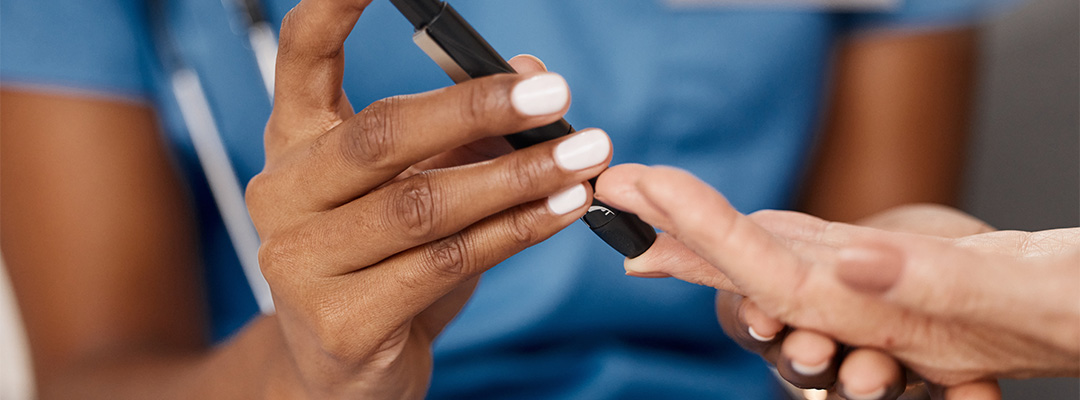
As a complex disease, diabetes can affect many areas of the body. The UAB Comprehensive Diabetes Center is comprised of over 200 researchers from 10 different schools and many departments to holistically approach the disease.
Additionally, UAB Medicine’s Multidisciplinary Comprehensive Diabetes Clinic (MCDC) helps address many facets of diabetes. It offers the expertise and compassion of UAB Medicine’s top specialists in a single location, and you can see an endocrinologist and a registered dietitian/certified diabetes educator in a single visit. Appointments with other specialists are available as needed.
-
Heart Disease and Stroke
Heart Disease and Stroke
Individuals with diabetes are twice as likely as those without the disease to have heart disease or a stroke. Individuals with diabetes are also more likely to develop heart disease or have a stroke at an earlier age. Over time, high blood glucose levels lead to deposit of fatty materials on the walls of blood vessels, restricting blood flow. Diabetes is a risk factor for heart disease and stroke. Other controllable risk factors for heart disease and stroke include obesity around the waist, abnormal cholesterol levels, high blood pressure, and smoking. Healthy lifestyle choices (heart-healthy diet, exercise, quitting smoking) can help to prevent or delay heart disease and stroke.
-
Diabetic Neuropathy: Nerve Damage
Diabetic Neuropathy: Nerve Damage
Over time, individuals with diabetes may develop nerve damage. Symptoms may include pain, tingling, or loss of feeling in the hands, arms, feet and legs. Nerve problems may occur in all organ systems including the heart and digestive tract. Some people with neuropathy may not notice any symptoms. Risk of developing nerve problems increases with age and the duration of diabetes and may be more common in individuals who have difficulty controlling their blood sugar levels. High blood sugar and overweight may also increase the likelihood of developing neuropathy. Approximately 60-70 percent of people with diabetes have some form of neuropathy. The best way to prevent diabetic neuropathies is to keep blood sugar as close to possible to the normal range.
-
Diabetic Nephropathy: Kidney Disease
Diabetic Nephropathy: Kidney Disease
Diabetic kidney disease takes many years to develop. It is rarely seen in people who have had diabetes less than 10 years. During the first stage of kidney damage, small amounts of protein leak into the urine, but kidney function usually remains normal. As the disease progresses, more protein leaks into the urine, and the kidneys’ function begins to drop. Blood pressure often rises as the kidney function begins to fall. As patients’ kidneys fail, they will either have to undergo dialysis or a kidney transplant. High blood pressure can increase the chances of developing kidney disease. The progression of kidney disease can be slowed by drugs used to treat high blood pressure. Other drugs may also be necessary. To minimize the risks of kidney disease, patients should work with their physicians to be certain blood glucose levels and blood pressure are kept within the normal range. Annual screening of urine can detect early signs of kidney damage.
-
Diabetic Retinopathy: Blindness
Diabetic Retinopathy: Blindness
High blood sugar levels can cause damage to multiple parts of the eye, and retinopathy is the most common damage observed in diabetes patients. The retina is the area at the back of the eye which senses incoming light.
High blood sugar levels and high blood pressure can cause damage to the tiny blood vessels of the retina. Leaking of blood into the eye and the growth of new blood vessels can lead to the loss of sight over time.
At first, it may not be possible to notice any changes in sight, but an eye exam can detect early damage. Signs of retina damage include blurred vision, pain or pressure in the eye, and trouble seeing out of the corner the eye.
Other eye problems caused by diabetes include cataracts (clouding of the lens of the eye) and glaucoma (pressure in the eye resulting in blindness). Keeping blood glucose levels and blood pressure as close to normal as possible are the best ways to reduce the risk of eye damage. Have a professional eye exam once each year to detect early damage. This will allow treatment to prevent more serious problems.